
Marcus Gheeraerts the Younger
Encyclopedia
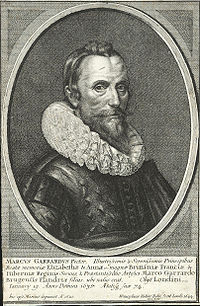
Bruges
Bruges is the capital and largest city of the province of West Flanders in the Flemish Region of Belgium. It is located in the northwest of the country....
, c. 1561/62 – 19 January 1636) was an artist of the Tudor court, described as "the most important artist of quality to work in England in large-scale between Eworth
Hans Eworth
Hans Eworth was a Flemish painter active in England in the mid-16th century. Along with other exiled Flemings, he made a career in Tudor London, painting allegorical images as well as portraits of the gentry and nobility. About 40 paintings are now attributed to Eworth, among them portraits of...
and Van Dyck
Anthony van Dyck
Sir Anthony van Dyck was a Flemish Baroque artist who became the leading court painter in England. He is most famous for his portraits of Charles I of England and his family and court, painted with a relaxed elegance that was to be the dominant influence on English portrait-painting for the next...
" He was brought to England as a child by his father Marcus Gheeraerts the Elder
Marcus Gheeraerts the Elder
Marcus Gheeraerts the Elder was a Flemish printmaker and painter associated with the English court of the mid-16th Century and mainly remembered as the illustrator of the 1567 edition of Aesop's Fables.-Biography:...
, also a painter
Painting
Painting is the practice of applying paint, pigment, color or other medium to a surface . The application of the medium is commonly applied to the base with a brush but other objects can be used. In art, the term painting describes both the act and the result of the action. However, painting is...
. He became a fashionable portraitist in the last decade of the reign of Elizabeth I
Elizabeth I of England
Elizabeth I was queen regnant of England and Ireland from 17 November 1558 until her death. Sometimes called The Virgin Queen, Gloriana, or Good Queen Bess, Elizabeth was the fifth and last monarch of the Tudor dynasty...
under the patronage of her champion and pageant-master Sir Henry Lee
Henry Lee of Ditchley
Sir Henry Lee KG , of Ditchley, was Master of the Ordnance under Queen Elizabeth I of England.-Life:Lee became Queen Elizabeth I’s champion in 1570 and was appointed Master of the Royal Armouries in 1580, an office which he held until his death...
, introducing a new aesthetic in English court painting that captured the essence of a sitter through close observation. He became a favorite portraitist of James I
James I of England
James VI and I was King of Scots as James VI from 24 July 1567 and King of England and Ireland as James I from the union of the English and Scottish crowns on 24 March 1603...
's queen Anne of Denmark
Anne of Denmark
Anne of Denmark was queen consort of Scotland, England, and Ireland as the wife of King James VI and I.The second daughter of King Frederick II of Denmark, Anne married James in 1589 at the age of fourteen and bore him three children who survived infancy, including the future Charles I...
, but fell out of fashion in the later 1610s.
Family
Marcus Gheeraerts the Younger was the son of the artist Marcus Gheeraerts the Elder and his wife Johanna. Hardly anything is known of the paintings of the elder Gheeraerts, although his work as a printmaker reached around Europe.Like other Protestant artists, Gheeraerts the Elder fled to England with his son to escape persecution in the Netherlands under the Duke of Alva. His wife was a Catholic and remained behind; she is assumed to have died a few years later. Father and son are recorded living with a Dutch servant in the London parish of St Mary Abchurch
St Mary Abchurch
St Mary Abchurch is a Church of England church on Cannon Street in the City of London. Dedicated to the Blessed Virgin Mary, it is first mentioned in 1198-99.-History:The church dates back to the twelfth century...
in 1568. On 9 September 1571, the elder Gheeraerts remarried. His new wife was Susanna de Critz, a member of an exiled family from Antwerp.
It is uncertain by whom young Marcus was trained, although it is likely to have been his father; he was possibly also a pupil of Lucas de Heere
Lucas de Heere
Lucas de Heere was a Flemish portrait painter, poet and writer.De Heere was a Protestant and became a refugee from the Dutch Revolt against Philip II of Spain, who tried to suppress Protestantism...
. Records suggest that Marcus was active as a painter by 1586 In 1590 he married Magdalena, the sister of his stepmother Susanna and of the painter John de Critz
John de Critz
John de Critz or John Decritz was one of a number of painters of Flemish and Dutch origin active at the English royal court during the reigns of James I of England and Charles I of England...
. The couple had six children, only two of whom seem to have survived—a son, Marcus III (c. 1602-c. 1654), also a painter, and a son Henry (1604-August 1650). His half-sister Sara married the painter Isaac Oliver
Isaac Oliver
Isaac Oliver was a French-born English portrait miniature painter.-Life and work:Born in Rouen, he moved to London in 1568 with his Huguenot parents Peter and Epiphany Oliver to escape the Wars of Religion in France...
in 1602.
A new aesthetic
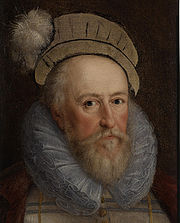
Roy Strong
Sir Roy Colin Strong FRSL is an English art historian, museum curator, writer, broadcaster and landscape designer. He has been director of both the National Portrait Gallery and the Victoria and Albert Museum in London...
identified a set of portraits of William Cecil, 1st Baron Burghley
William Cecil, 1st Baron Burghley
William Cecil, 1st Baron Burghley , KG was an English statesman, the chief advisor of Queen Elizabeth I for most of her reign, twice Secretary of State and Lord High Treasurer from 1572...
dated to around 1586 as likely based on an original by Gheeraerts. Although raised in England, Gheeraerts' work reflects a continental aesthetic very different to the flat modeling of features and pure, brilliant colours associated with Elizabethan artists such as Nicolas Hilliard. "The implications suggest that Oliver and Gheeraerts singly or together visited Antwerp in the late eighties and were influenced by the portrait style of Frans Pourbus
Frans Pourbus the Elder
Frans Pourbus the elder was a Flemish Renaissance painter.He was known primarily for his religious and portrait painting and worked mainly in Antwerp. His father was painter Pieter Pourbus and his son was painter Frans Pourbus the younger.-External links:*...
." From around 1590, Gheeraerts led a "revolution" in English portraiture. For the first time in English art sitters were rendered in three dimensions, achieving a life-like impression through tonality and shadow. New too were capturing the character of individual sitters through close observation and the use of sombre colour and greyed flesh tones. Gheeraerts was one of the first English artists to paint on canvas rather than wood panel, allowing much larger pictures to be produced. He also introduced the full-length figure set out-out-of-doors in a naturalistic landscape for full-scale portraiture, a feature seen in portrait miniature
Portrait miniature
A portrait miniature is a miniature portrait painting, usually executed in gouache, watercolour, or enamel.Portrait miniatures began to flourish in 16th century Europe and the art was practiced during the 17th century and 18th century...
s of the same era.
The need for assistants to complete the backgrounds and details of the new large canvas paintings, and the numbers of surviving copies and variants of Gheeraerts' works, suggest a studio or workshop staffed with assistants and apprentices. There are similarities of features between Gheeraert's portraits of Robert Devereux, 2nd Earl of Essex
Robert Devereux, 2nd Earl of Essex
Robert Devereux, 2nd Earl of Essex, KG was an English nobleman and a favourite of Elizabeth I. Politically ambitious, and a committed general, he was placed under house arrest following a poor campaign in Ireland during the Nine Years' War in 1599...
and miniatures of Essex by Gheeraerts' brother-in-law Isaac Oliver, and later between their portraits of Anne of Denmark, but it is unknown whether the two artists collaborated or shared patterns for portraits.
Elizabethan success
_by_marcus_gheeraerts_the_younger.jpg)
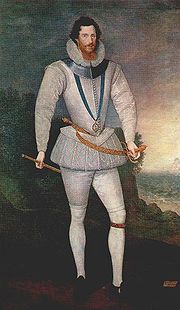
Queen's Champion
The feudal holder of the Manor of Scrivelsby since 1066 has held that manor from the Crown by grand serjeanty of being The Honourable The King's/Queen's Champion. Such person is also Standard Bearer of England.- Origins :...
in the autumn of 1590, was the architect of much of the chivalric
Chivalry
Chivalry is a term related to the medieval institution of knighthood which has an aristocratic military origin of individual training and service to others. Chivalry was also the term used to refer to a group of mounted men-at-arms as well as to martial valour...
pageantry at the court of Elizabeth I. Lee became Gheeraerts' patron around 1590, and Gheeraerts quickly became fashionable in court circles, creating emblematic portraits associated with the elaborate costumed iconography
Iconography
Iconography is the branch of art history which studies the identification, description, and the interpretation of the content of images. The word iconography literally means "image writing", and comes from the Greek "image" and "to write". A secondary meaning is the painting of icons in the...
of Lee's Accession Day tilt
Accession Day tilt
The Accession Day tilts were a series of elaborate festivities held annually at the court of Elizabeth I of England to celebrate her Accession Day, 17 November, also known as Queen's Day...
s. The queen likely sat to him for the Ditchley Portrait of 1592, and her favourite
Favourite
A favourite , or favorite , was the intimate companion of a ruler or other important person. In medieval and Early Modern Europe, among other times and places, the term is used of individuals delegated significant political power by a ruler...
the Earl of Essex employed Gheeraerts from 1596. The royal accounts for 1596–98 also include payments for decorative work by "Marcus Gerarde".
The Ditchley Portrait seems to have always been at Lee's home in Oxfordshire, and was likely painted for (or commemorates) her two-day visit to Ditchley in 1592. In this image, the queen stands on a map of England, her feet on Oxfordshire. The painting has been trimmed and the background poorly repainted, so that the inscription and sonnet are incomplete. Storms rage behind her while the sun shines before her, and she wears a jewel in the form of a celestial or armillary sphere
Armillary sphere
An armillary sphere is a model of objects in the sky , consisting of a spherical framework of rings, centred on Earth, that represent lines of celestial longitude and latitude and other astronomically important features such as the ecliptic...
close to her left ear. The new portrait aesthetic did not please the aging queen, and in the many versions of this painting made with the allegorical items removed, likely in Gheeraerts' workshop, Elizabeth's features are "softened" from the stark realism of her face in the original. One of these was sent as a diplomatic gift to the Grand Duke of Tuscany
Ferdinando I de' Medici, Grand Duke of Tuscany
Ferdinando I de' Medici, Grand Duke of Tuscany was Grand Duke of Tuscany from 1587 to 1609, having succeeded his older brother Francesco I.-Biography:...
and is now in the Palazzo Pitti
Palazzo Pitti
The Palazzo Pitti , in English sometimes called the Pitti Palace, is a vast mainly Renaissance palace in Florence, Italy. It is situated on the south side of the River Arno, a short distance from the Ponte Vecchio...
.
Around 1594, Gheeraerts painted a portrait of Lee's cousin Captain Thomas Lee
Thomas Lee (army captain)
Thomas Lee was an English army captain, who served under Queen Elizabeth I and spent most of his career in Ireland during the Tudor conquest of that country. Although of middle rank, he played a turbulent role in the factional politics of the time and was highly active during the Nine Years war...
standing in a landscape wearing Irish dress. The iconography of the portrait alludes to Captain Lee's service in Ireland. Gheeraerts also painted several portraits of Sir Henry Lee himself, including a full-length portrait in his robes of the Order of the Garter
Order of the Garter
The Most Noble Order of the Garter, founded in 1348, is the highest order of chivalry, or knighthood, existing in England. The order is dedicated to the image and arms of St...
(1602).
Essex (whose mother Lettice Knollys, Countess of Leicester
Lettice Knollys
Lettice Knollys , Countess of Essex and Countess of Leicester , was an English noblewoman and mother to the courtiers Robert Devereux, 2nd Earl of Essex and Lady Penelope Rich; through her marriage to Elizabeth I's favourite, Robert Dudley, Earl of Leicester, she incurred the Queen's undying...
was related to Sir Henry Lee) seems to have used Gheeraerts exclusively for large-scale portraits from the mid-1590s. The first of these is the 1596 full-length portrait of Essex at Woburn Abbey, where he stands in a landscape with the burning Spanish city of Cadiz
Cádiz
Cadiz is a city and port in southwestern Spain. It is the capital of the homonymous province, one of eight which make up the autonomous community of Andalusia....
in the background. Many half-length and three-quarter-length portraits of Essex with plain backgrounds appear to be studio variants of sittings to Gheeraerts. Like Lee, Essex was an important participant in the Accession Day tilts.
Sir Roy Strong wrote of the Ditchley and Woburn Abbey portraits:
Gheeraerts' popularity does not seem to be have been tainted by the patronage of participants in the Essex Rebellion (both Essex and Thomas Lee were executed for treason in 1602).
Jacobean years
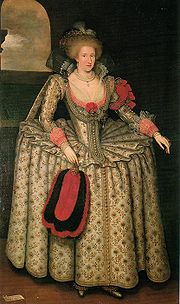
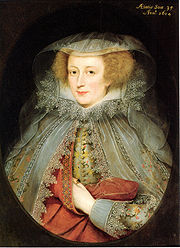
Elizabeth of Bohemia
Elizabeth of Bohemia was the eldest daughter of King James VI and I, King of Scotland, England, Ireland, and Anne of Denmark. As the wife of Frederick V, Elector Palatine, she was Electress Palatine and briefly Queen of Bohemia...
. A portrait of Anne, likely wearing mourning for her son Henry Frederick, Prince of Wales
Henry Frederick, Prince of Wales
Henry Frederick Stuart, Prince of Wales was the elder son of King James I & VI and Anne of Denmark. His name derives from his grandfathers: Henry Stuart, Lord Darnley and Frederick II of Denmark. Prince Henry was widely seen as a bright and promising heir to his father's throne...
in the winter of 1612-13 is also attributed to Gheeraerts.
His 1611 portrait of Frances Howard, Countess of Hertford in rich attire framed by a draped silk curtain, with a fringed pelmet
Pelmet
A pelmet is a framework placed above a window, used to conceal curtain fixtures. These can be used decoratively and also help insulate the window by preventing convection currents. It is similar in appearance to a valance, which performs the same function but is made of fabric...
across the top of the canvas, is the first known instance of a portrait setting that would be used by Hilliard's former apprentice William Larkin
William Larkin
William Larkin was an English painter active from 1609 until his death in 1619, known for his iconic portraits of members of the court of James I of England which capture in brilliant detail the opulent layering of textiles, embroidery, lace, and jewellery characteristic of fashion in the Jacobean...
in a series of full-length portraits between 1613 and 1618. Overall, Gheeraerts' portraiture in the Jacobean era
Jacobean era
The Jacobean era refers to the period in English and Scottish history that coincides with the reign of King James VI of Scotland, who also inherited the crown of England in 1603 as James I...
is characterized by the "quietness, pensiveness, and gentle charm of mood" seen in his portraits of Catherine Killigrew, Lady Jermyn (1614) and Mary Throckmorton, Lady Scudamore (1615).
Isaac Oliver died in 1617, and around the same time Gheeraerts' position at court began to decline as the result of competition from a new generation of immigrants. Anne of Denmark died in 1619, and although Gheeraerts was part of her funeral procession as "Queen's Painter", the Netherlander Paul van Somer had likely displaced him as her chief portraitist some time before. For the last twenty years of his life Gheeraerts was employed chiefly by the country gentry and by academic sitters.
Gheeraerts was a member of the Court of the Painter-Stainers' Company in the 1620s and had an apprentice, Ferdinando Clifton, who was a freeman of the Company in 1627. Gheeraerts died on 19 January 1636.

